
table of contents
- Suitable greenhouse
- Planting time
- Optimal soil
- Instructions for planting
- Fertilize
- to water
- Pricking out / cutting
- Important care advice: pollination
- Pests and diseases
- frequently asked Questions
Unfortunately, there is no good harvest guarantee for tomatoes (Solanum lycopersicum) outdoors. In the greenhouse the warmth is right and the rain is denied access, so that tomatoes feel good. With the right care, cultivation is a sure-fire success.
In a nutshell
- Planting possible from the end of April / mid-May
- Observe the minimum distance and attach a climbing aid
- fertilize with compost or other organic fertilizers, keep soil moist
- regularly skimmed and free of leaves
- selectively pollinate by hand
Suitable greenhouse
Every tomato plant is happy about a large glass greenhouse. However, it is not a must for covered cultivation. Tomato houses made of foil are also available in stores. Their lifespan is shorter, but they are comparatively very cheap. Smaller of them are even suitable for growing tomatoes on the balcony. Your own construction can also be built inexpensively. It is sufficient if it has a translucent roof and three sides. The ideal location for the greenhouse is in a sunny location, as tomato scientifically loves and needs warmth.
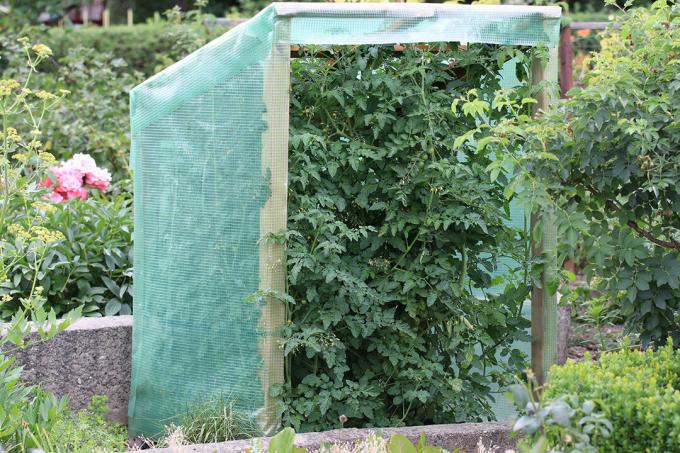
Planting time
Outside, tomatoes are not planted until mid-May. This planting time also applies to greenhouses that are not closed on all sides. Because even low temperatures can destroy tomato plants. In the glass greenhouse you can plant tomatoes around mid to late April. The young plant should then have a height of about 20-25 cm and the first flower cluster should be visible.

Tip: Instead of buying young tomato plants in stores, you can also bring them forward at home from around mid-February. Either in the house on a warm and bright window sill or in the greenhouse, if it can be heated.
Optimal soil
The seeds are sown in poor potting soil. The young plants, on the other hand, must be planted in a soil that has the following properties:
- nutritious
- relaxed
- permeable to water
- with a pH of 6.5 to 7
Add nutrients to the soil by adding a good serving of ripe compost or other slow release organic fertilizer before planting. An unsuitable pH value can either be increased by adding lime or lowering it with sulfur, depending on the value.
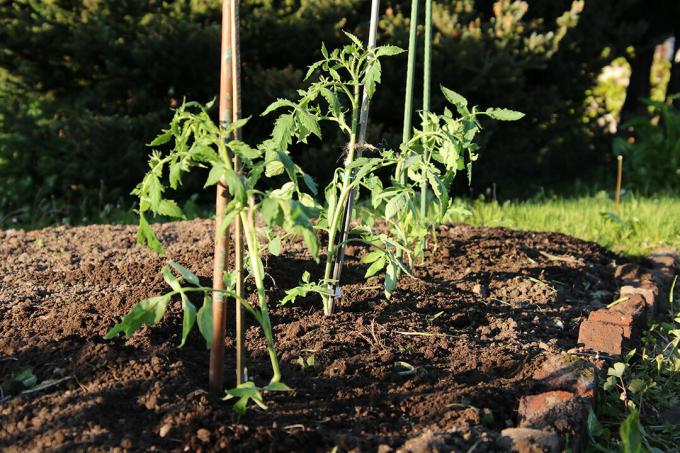
Tip: If you want it to be quick and practical, use special tomato soil. It is tailored to the needs of this nightshade plant.
Instructions for planting
- Loosen the soil deeply and remove any weeds.
- Then dig out planting holes that are about 5 cm deeper than the ball of the pot. Keep a minimum distance of about 80 cm between two rows. The minimum distance between two plants in a row should be about 60 cm.
- First immerse plants with dry soil in buckets of water until the soil is soaked.
- Snap off the cotyledons to prevent disease.
- Carefully remove the ball of earth from the pot.
- Place the tomato plant in the planting hole. In the tomato house with an open front, orient the flower stem inwards.
- Fill the planting hole with soil, which you then carefully press down.
- Thoroughly water the soil.
- Use a climbing aid right away so that the tomato can grow upright on it and later find a good hold. Long spiral rods made of metal are ideal as a climbing aid. Tomato plants can also be tied to the greenhouse ceiling with strings.
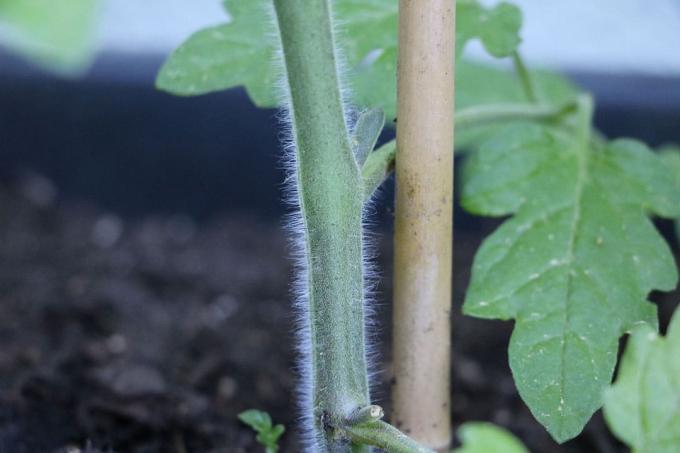
Fertilize
The tomato is one of the so-called strong eaters. With the good starting supply during the planting period, it will only be there for a short time. That is why Solanum lycopersicum must be fertilized regularly with ripe compost during the entire vegetation period. Only sparingly until flowering, then every two weeks. The following organic fertilizers are ideally suited as supplementary nutrient suppliers:
- Horn shavings
- Nettle manure
- Comfrey manure
- Rock flour
- Mulch
If a mineral fertilizer is used, the focus should be on phosphorus, potassium, magnesium and sulfur as well as trace elements boron, iron and manganese. Nitrogen is also essential for tomatoes. However, only a low-nitrogen fertilizer should be used in the greenhouse.
to water
The soil must never dry out completely. Likewise, the earth must not be completely wet, and certainly not long-term waterlogging. When watering, the water must not wet the leaves. The pouring rules at a glance:
- Use rainwater or stale tap water
- water at regular intervals
- needs-based and heat-dependent
- early morning is ideal
- water in the evenings in summer
- check soil moisture beforehand
- it is better to water more often than with large amounts of water
- Put water directly on the roots
- Use a watering can, do not use a hard jet of water from a hose

Pricking out / cutting
Tomatoes like to proliferate, but space in the greenhouse is limited. But the risk of brown rot can also be minimized with courageous cutting. That Skinning the tomatoes directs the energy away from the leaf mass and into the fruiting process. About 4-5 fruit-bearing shoots should remain on each tomato plant.
- Completely free the lower 40 cm of the plant from leaves
- start pruning one week after planting out
- Repeat every two weeks until harvest
- remove all stinging shoots from the leaf axils
- snap it off with your fingers
- do not use scissors, do not tear out
- only cut off larger shoots carefully
- Shorten main shoots after the fifth inflorescence (load limit)

Tip: From August onwards, new flowers have little chance of turning into red tomatoes. Remove these consistently in order to direct the energy into already set fruits.
Important care advice: pollination
With tomatoes, insects and wind ensure that pollination goes smoothly. In a closed greenhouse, apart from the ventilation window, both are rarely or not at all. That's why the gardener has to help. Here are a few alternatives:
- Shake the inflorescence every two days
- briefly touch the inside of the flower with an electric toothbrush
- Brush over pollen sacs and stigma with a soft brush
- Simulate wind with a fan
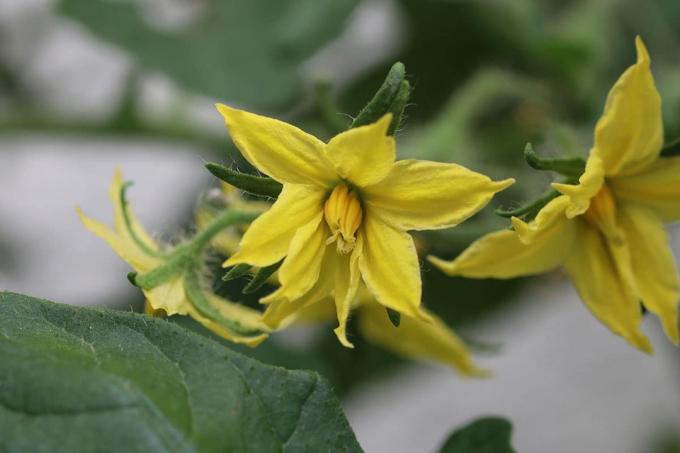
In order for this care instruction to actually lead to “harvestable” success, the air temperature and humidity in the greenhouse of the tomatoes must be right. Make sure that the temperature does not exceed 30 ° C and that the humidity is between 50 and 80%. Otherwise the pollen can stick together. On the other hand, air that is too cool reduces the pollen's ability to germinate.
Pests and diseases
Tomato plants are not just a gardener's favorite. They are also on the menu of some pests, such as aphids and white flies. The high humidity in the greenhouse is particularly beneficial for spider mites and tomato leaf miners. In the closed space there is also more to be seen Tomato diseases:
- Bacterial wilt
- Velvet spot disease
- Gray mold
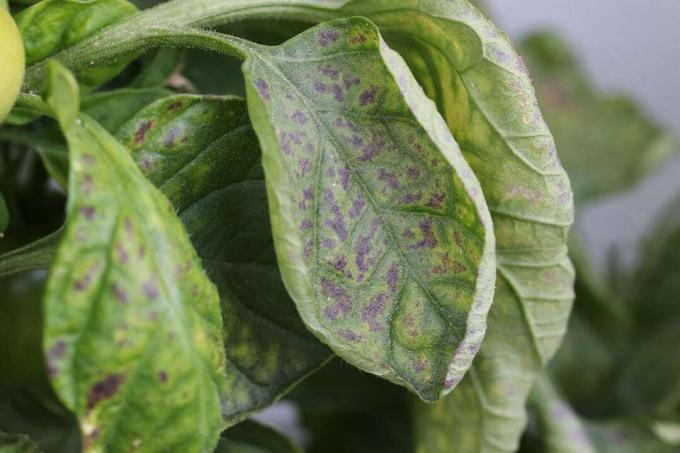
Keep an eye on your tomato plants. Act as soon as spots or evidence appear on leaves or fruits or parts of the plant peel off. Or if you discover pests.
frequently asked Questions
Bees and other pollinating insects have a sensitive olfactory organ. If the space in the greenhouse allows, plant a few fragrant plants in it. Chances are, their scent will attract bees. However, you have to open a window or the greenhouse door for them.
Most diseases are favored by too close planting. It is understandable to want to increase the harvest volume with many plants, but it is essential to keep the recommended minimum distance when planting in the greenhouse.
Pests and diseases are not always responsible for unsightly changes in leaves and fruits. A care error can also be a possible cause. Uneven water supply causes the fruits to burst, too much sun causes sunburn. Blossom end rot usually indicates a lack of calcium, green collar indicates a lack of potassium and fertilization that is too nitrogen-based.
Yes, but with reservations. The tomato house must be heated to 22-24 ° C in winter. In addition, not every variety is suitable for wintering. It works best with wild or cherry tomatoes.


